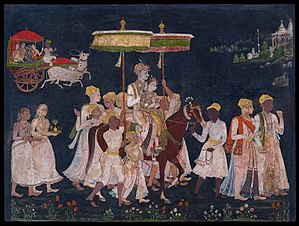
Bhagamati (Hyder Mahal) was a queen of Sultan Muhammad Quli Qutb Shah, in whose honour Hyderabad was supposedly named.[1] She is also known by the name Bhagyawati[2] There exists debate among scholars about whether there existed any Bhagamati at all and whether she influenced the naming.[3][4]
Popular narrative[edit]
Bhagmati was born in 'Chichlam' (place not identified with certainty) in a Hindu family; she was a local nautch-girl.[3] Qutb Shah met her whilst riding out, fell in love to the extent of having constructed the bridge known as Purana Pul as a means of meeting her regularly, and entered into a marriage.[3][5] Accordingly, the sultan founded a city around her birth-place and named it "Bhaganagar" or "Bhāgyanagar" in her honor.[4] After she converted to Islam and adopted the title Hyder Mahal, the city was renamed Hyderabad.[5]
Scholarly debates[edit]
That Purana pul was completed in 1578 after 2 years of construction; Qutb Shah (b:1566) was romancing Bhagmati as young as ten years.[3] Furthermore, no tomb was built over her last remains unlike other leading female figures of the court; no inscription or coin of that period mentions her name.[3][4] The chroniclers who mentioned of her were either from North of the Sultanate, who did not visit Hyderabad or foreigners, who arrived long after her death; contemporary Deccani sources including Qutb Shah himself don't mention of her at all.[4][5] The conferral of 'Hyder', an immensely sacred Islamic attribute on a nautch-girl has been doubted as well.[3][5] All these cast significant doubts on the authenticity of Bhagmati's existence.[4]
Some however assert that the historicity of multiple sources can't be rejected as hearsay due to their foreign nature, sources exist in that the State Museum in Public Gardens has a portrait of her commissioned around 1750, and that her conspicuous absence from Deccani sources were a result of damnatio memoriae.[4][5] Others believe Bhagnagar (which was indeed named after her) was a separate village which has nothing to do with today's Hyderabad.[4]
References[edit]
- ^ "Hyderabad or Bhagyanagar? The tiff continues". Deccan Chronicle. 29 April 2014. Retrieved 16 December 2020.
- ^ Jagir Singh Bajwa, Ravinder Kaur (2007). Tourism Management. APH Publishing Corporation. p. 267. ISBN 978-8131300473.
- ^ a b c d e f Ifthekhar, J. S. (11 November 2013). "Did Bhagmati really exist?". The Hindu. ISSN 0971-751X. Retrieved 16 December 2020.
- ^ a b c d e f g Ayoob Ali Khan, Mir (22 March 2010). "For Hyderabadis, Bhagmati is vital part of history | Hyderabad News - Times of India". The Times of India. Retrieved 16 December 2020.
- ^ a b c d e Pillai, Manu S. (15 November 2018). "Opinion | A Hyderabadi conundrum". LiveMint. Retrieved 16 December 2020.
Well, that’s interesting to know that Psilotum nudum are known as whisk ferns. Psilotum nudum is the commoner species of the two. While the P. flaccidum is a rare species and is found in the tropical islands. Both the species are usually epiphytic in habit and grow upon tree ferns. These species may also be terrestrial and grow in humus or in the crevices of the rocks.
View the detailed Guide of Psilotum nudum: Detailed Study Of Psilotum Nudum (Whisk Fern), Classification, Anatomy, Reproduction